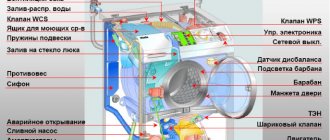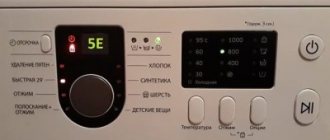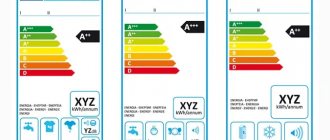When buying a washing machine, we are always interested in the volume of the drum and its maximum load. But as soon as we start using the machine, we don’t even think about how much laundry we put in the washing machine and how much it weighs. Of course, no one will weigh the laundry on a scale before washing, but constant reloading can lead to rapid wear of the equipment.
On the front panel of the equipment they write in large numbers 4, 5, 6 or even 8 kg. But what does this mean, maximum load of laundry? But then the question arises, what kind of laundry: dry or wet? These are the questions we will try to answer.
Why do you need to know the weight of dry laundry?
The larger the load capacity - usually 3-8 kg, the more items can be washed per cycle. The smaller the capacity, the more stages and the more the consumer spends water, powder, and electricity. When choosing a washing machine, consider your needs:
- washing frequency;
- the amount of laundry that needs to be washed at a time.
If you have a spacious drum with plenty of room, and you wash almost every day, you don’t need to worry. If the load is small - 4-5 kg, and a lot of dirty things accumulate, you cannot do without calculations. Before throwing things into the tank, you should calculate the weight of the laundry to be washed. If you put more into the drum than what is provided by the manufacturer, the wash will be of poor quality.
Why is it necessary to know the weight of things?
The weight of dry laundry depends on what items fit in the washing machine. If you choose an automatic program, you should still take into account the number of washes and how many times you plan to wash the laundry. It will not be possible to save and conserve cold water, powder and electricity. By loading more things into the car than the operation allows, the equipment will not last long.
Loading laundry into SMA
On the front panel of washing equipment they write 3, 5, or even 8 possible kilograms. Due to the excess of laundry needed for washing, increased vibration of the unit occurs, which, accordingly, can lead to rapid breakdown. Also, an excess of things in the drum is a big load for the motor, which can even burn out.
Expert opinion
I work in the household appliance repair industry. Extensive experience in restoring washing machines and dishwashers.
Ask a Question
The instructions indicate dry weight! This is important because some porous items, such as down jackets, absorb a lot of water. And the amount of water needed is determined by the free surface. As a result, overload may occur.
How to load laundry correctly?
Loading the washing machine is carried out according to strict rules. Necessary:
- Decide on the material - what needs to be washed.
- Sort items by color.
- Distribute according to soil level - wash very dirty items in a separate batch.
- Turn clothes with zippers, buttons, snaps, and fittings inside out.
- Place items with accessories in special bags. The same goes for small items - socks, scarves, etc.
Correct loading of the washing machine
Washing machine programs always indicate all the necessary information - you need to pay due attention to it. Even the simplest models have separate programs for jeans, wool, delicate fabrics, and synthetics.
The creators of washing machines do this for a reason - a certain type of fabric requires its own water temperature. In addition, the machine may even have parameters for the number of drum rotations and rinses, and so on.
More than one specialist worked on the creation of each mode, so there is no need to ignore the choice of the proper program for a particular type of fabric. It is necessary to properly pack things before washing, and then you will not have to blame television programs for bad advertising.
Are you unplugging your washing machine?
Oh yes! No
For example, experienced housewives have long known that white linen should never be mixed with colored items when washing. If such products are not in danger in such a situation, then white ones will easily acquire an unnecessary shade.
Certain washing powders are intended for different things. Those that can easily cope with preserving the bright shade of colored items, unfortunately, will ruin white items.
Expert opinion
I work in the household appliance repair industry. Extensive experience in restoring washing machines and dishwashers.
Ask a Question
Many users often forget to check their pockets when loading laundry. Inattention and forgetfulness can lead to water getting into the drain filters and further clogging.
If you leave something dyed in your pocket, the results of such a wash will most likely leave you completely stunned. When loading laundry into the machine, you should fasten all the zippers and buttons, because the zipper can tear everything in its path. It is recommended to place delicate items (for example, nylon tights and stockings, bras) in mesh bags specially designed for this purpose before placing them in the washing assistant.
How to determine weight?
To find out how many kilograms can be loaded into the SMA, you need to look at the instructions. The technical features of the device and the year of manufacture are important. An automatic washing machine (CAW) does not always have a minimum limitation. Some people agree to wash one sock or run the water completely “idle”. But many models are limited to 1–1.5 kg.
When filling the machine, take into account the type of fabric: this affects the “wet” mass. Products made from different fabrics take up different volumes. With a light structure - more, dense fabrics - less. One kg of wet wool will weigh more than one kg of wet cotton. Manufacturers indicate that SMA should be loaded according to the technical standard, but there is no need to compact it.
Minimum load
Let's start with the minimum amount of laundry you can put in the drum, because the minimum is just as important as the maximum. The number of items in the drum during washing will determine the degree of vibration during spinning, and therefore the period of uninterrupted operation of the machine.
Any automatic washing machine must contain at least 1-1.5 kg of dry laundry.
Not all washing machine manufacturers indicate this parameter, saying that it is better to put more in the machine to save energy. However, for some, the need to wash three pairs of socks or one T-shirt is more important than saving money, which is not at all safe for equipment. The 1 kg limit is not accidental; the fact is that when spinning at high speeds, the laundry should be evenly distributed throughout the drum for balance.
An unbalanced drum will begin to vibrate more forcefully. Even if the machine is not a narrow model and is installed well, internal vibration remains, and it can cause microcracks. We hope now you understand why you shouldn’t wash just one pillowcase or one panties.
Maximum weight of dry or wet items
Now let's talk about the number that is indicated on the front panel of the washing machine, more precisely, about its maximum load. Today, automatic machines can have a load of 8, 10 and even 12 kg of dry laundry. In reality, this is a lot; for clarity, let’s give an example: a set of bed linen consisting of one duvet cover, one sheet and two pillowcases weighs on average 1.3 kg when dry. This means that about 9 such sets can be placed in the drum of a washing machine with a load of 12 kg. However, you should not blindly trust the numbers; everything is not as simple as it seems.
For your information! Some manufacturers intentionally overestimate this parameter in order to attract attention to the car model and increase sales.
The technical meaning of the maximum load of the machine in kilograms indicated in the passport is as follows - the machine must rotate the indicated weight without overloading the engine during its service life. But this does not mean at all that you should put such a quantity of linen and clothes into the drum every time, weighing it on scales, and it is unlikely that you will succeed. In addition, at maximum load the manufacturer does not guarantee the quality of washing. Most users note that even if they wanted to, they cannot cram and compact the maximum possible weight.
Most likely, this is also no coincidence. Some washing machine manufacturers, for example Bosch, when testing the machine for maximum load, use dense, heavy fabric cut into small pieces. And, as you know, the denser the fabric, the heavier it is and takes up less volume. Therefore, it easily enters the drum, while there is enough space in the drum for it to flop around. In accordance with these tests, the manufacturer indicates the maximum load with some margin, so that the machine is not overloaded, even when fully loaded.
In reality, we wash clothes and things that are bulkier and therefore weigh less. In addition, water absorption depends on the density and composition of the fabric. Imagine a sofa blanket. When dry, it easily fits into a regular basin. But washing it in a basin by hand will be extremely difficult, almost impossible. It is much easier to wash it in a bathtub, which is several times larger in volume.
The same is true in the drum of a washing machine. The larger the item, the larger the load and drum volume should be. If you are going to wash jackets, down jackets, blankets in the machine, then you need to choose a machine with a larger load so that the clothes are washed well. The manufacturer takes this into account, and in the instructions for the machine writes the load of laundry for a specific washing mode.
Important! The weight of the loaded laundry is measured dry. No one will weigh wet laundry and put it in the machine; doing this is problematic.
After analyzing this table, we can conclude that regardless of the manufacturer of the washing machine, its load under different modes is approximately the same. The least amount of wool you can put in the drum is because it is the most voluminous and absorbs a lot of water. You shouldn't machine wash a lot of synthetic and delicate fabrics, otherwise they won't stretch and will be too wrinkled.
The most things you can load into the machine are cotton items, bedding and baby clothes. This does not mean that the drum should be filled to capacity. The drum must be filled 2/3 full, so the laundry can be washed and rinsed well. In addition, this will allow the laundry to be evenly distributed throughout the drum, which will not cause imbalance or poor spinning of the laundry. An imbalance can cause the machine to stop and an error to appear on the display, such as the ue error on a Samsung machine.
How to calculate the weight of laundry?
There is a maximum load table. It is compiled for a specific model. The weight depends on the fabric. To find out how much a duvet cover and sheet weigh, look at the special table. Here you will find out how much a T-shirt, jeans, tracksuit or business suit weighs. Having such a sign, you don’t have to weigh things. Knowing how many kilograms you can load at a time, you can quickly calculate the number of T-shirts or pillowcases that can be washed in one go. The weight in the table is indicated “dry”.
We correctly determine the weight
It would seem that nothing could be simpler than loading as much laundry into the washing machine as indicated on the machine panel or on its characteristics in the store. However, there are not those people who pre-weighed the laundry for subsequent washing.
As a result, the SMA is often heavily overloaded, which leads to its unnecessary wear and tear. In addition, in a jam-packed drum, stains simply cannot be removed from things.
Table - weight of various laundry for washing machine
Not all users of washing machines know that the maximum weight written on the panel is not available for all automatic programs. All this does not mean that you need to adapt and weigh the piles of laundry that have accumulated for washing at home. In most machines, full loading of the drum is possible only for cotton products, and even then not for all.
For example, for synthetics and delicate fabrics, as well as mixed fabrics, it is recommended to use only half the load. This type of loading is best used for express programs. Most operating instructions provide all the necessary information for a particular mode, but they are never read.
If you don’t have scales at hand, you can find out the required number at home. Some instructions sometimes contain information about how much a particular type of laundry weighs. For example, a tablecloth weighs on average 400-500 grams, children's onesies weigh less - 30-80 grams. At the same time, the weight of denim can reach 800 grams.
Of course, no one says that this information will be enough, and the weight of the indicated products will not fluctuate depending on many parameters. However, in order to enable the washing machine to wash things without overloading the drum, approximate data is sufficient.
Are you using citric acid?
Oh yes! No
Auto weighing
A feature through which the user receives several benefits:
- you don’t have to bother with calculations, checking the plates;
- resources are saved - water and electricity;
- the appropriate program is automatically selected;
- The SMA is protected from damage - there is a lock that will prevent the washing process from starting if it is overloaded.











